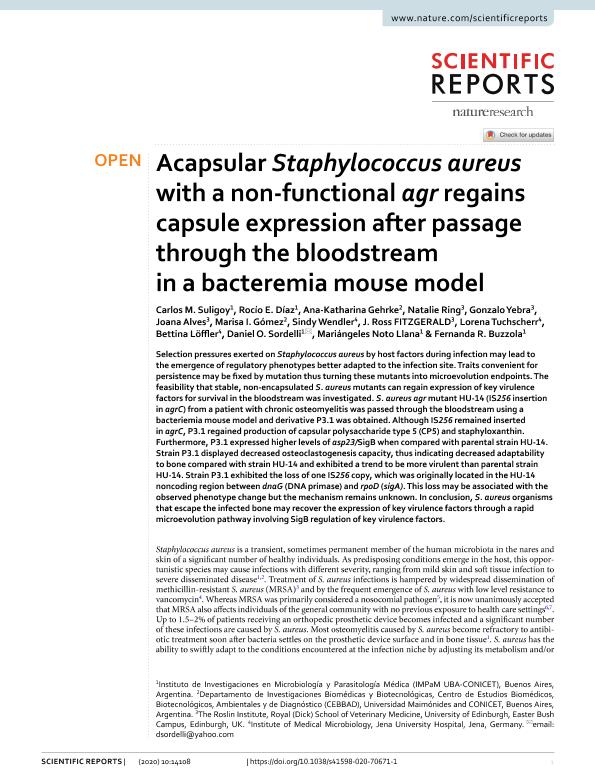Artículo
Acapsular Staphylococcus aureus with a non-functional agr regains capsule expression after passage through the bloodstream in a bacteremia mouse model
Suligoy Lozano, Carlos Mauricio ; Díaz, Rocío E.; Gehrke, Ana-katharina Elsa
; Díaz, Rocío E.; Gehrke, Ana-katharina Elsa ; Ring, Natalie; Yebra, Gonzalo; Alves, Joana; Gómez, Marisa Ileana; Wendler, Sindy; Fitzgerald, J. Ross; Tuchscherr, Lorena; Löffler, Bettina; Sordelli, Daniel Oscar
; Ring, Natalie; Yebra, Gonzalo; Alves, Joana; Gómez, Marisa Ileana; Wendler, Sindy; Fitzgerald, J. Ross; Tuchscherr, Lorena; Löffler, Bettina; Sordelli, Daniel Oscar ; Noto Llana, Mariangeles
; Noto Llana, Mariangeles ; Buzzola, Fernanda Roxana
; Buzzola, Fernanda Roxana
 ; Díaz, Rocío E.; Gehrke, Ana-katharina Elsa
; Díaz, Rocío E.; Gehrke, Ana-katharina Elsa ; Ring, Natalie; Yebra, Gonzalo; Alves, Joana; Gómez, Marisa Ileana; Wendler, Sindy; Fitzgerald, J. Ross; Tuchscherr, Lorena; Löffler, Bettina; Sordelli, Daniel Oscar
; Ring, Natalie; Yebra, Gonzalo; Alves, Joana; Gómez, Marisa Ileana; Wendler, Sindy; Fitzgerald, J. Ross; Tuchscherr, Lorena; Löffler, Bettina; Sordelli, Daniel Oscar ; Noto Llana, Mariangeles
; Noto Llana, Mariangeles ; Buzzola, Fernanda Roxana
; Buzzola, Fernanda Roxana
Fecha de publicación:
08/2020
Editorial:
Nature
Revista:
Scientific Reports
ISSN:
2045-2322
e-ISSN:
2045-2322
Idioma:
Inglés
Tipo de recurso:
Artículo publicado
Clasificación temática:
Resumen
Selection pressures exerted on Staphylococcus aureus by host factors during infection may lead to the emergence of regulatory phenotypes better adapted to the infection site. Traits convenient for persistence may be fixed by mutation thus turning these mutants into microevolution endpoints. The feasibility that stable, non-encapsulated S. aureus mutants can regain expression of key virulence factors for survival in the bloodstream was investigated. S. aureus agr mutant HU-14 (IS256 insertion in agrC) from a patient with chronic osteomyelitis was passed through the bloodstream using a bacteriemia mouse model and derivative P3.1 was obtained. Although IS256 remained inserted in agrC, P3.1 regained production of capsular polysaccharide type 5 (CP5) and staphyloxanthin. Furthermore, P3.1 expressed higher levels of asp23/SigB when compared with parental strain HU-14. Strain P3.1 displayed decreased osteoclastogenesis capacity, thus indicating decreased adaptability to bone compared with strain HU-14 and exhibited a trend to be more virulent than parental strain HU-14. Strain P3.1 exhibited the loss of one IS256 copy, which was originally located in the HU-14 noncoding region between dnaG (DNA primase) and rpoD (sigA). This loss may be associated with the observed phenotype change but the mechanism remains unknown. In conclusion, S. aureus organisms that escape the infected bone may recover the expression of key virulence factors through a rapid microevolution pathway involving SigB regulation of key virulence factors.
Palabras clave:
STAPHYLOCOCCUS AUREUS
,
CHRONIC INFECTION
,
CAPSULE
,
SIGB
Archivos asociados
Licencia
Identificadores
Colecciones
Articulos(IMPAM)
Articulos de INSTITUTO DE INVESTIGACIONES EN MICROBIOLOGIA Y PARASITOLOGIA MEDICA
Articulos de INSTITUTO DE INVESTIGACIONES EN MICROBIOLOGIA Y PARASITOLOGIA MEDICA
Citación
Suligoy Lozano, Carlos Mauricio; Díaz, Rocío E.; Gehrke, Ana-katharina Elsa; Ring, Natalie; Yebra, Gonzalo; et al.; Acapsular Staphylococcus aureus with a non-functional agr regains capsule expression after passage through the bloodstream in a bacteremia mouse model; Nature; Scientific Reports; 10; 1; 8-2020; 1-12
Compartir
Altmétricas



